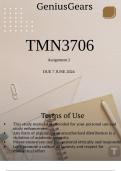TMN3706
Assignment 2
DUE 7 JUNE 2024
, Teaching Social Sciences
Summary
This analysis explores the fundamental distinctions between inquiry
learning and the expository approach, two prevalent educational
methodologies. Inquiry learning is a student-centered method that fosters
exploration, questioning, and the construction of knowledge through
active engagement and critical thinking. In contrast, the expository
approach is teacher-centered, emphasizing structured, clear, and efficient
transmission of information.
The subsequent discussion will detail the defining characteristics,
advantages, and disadvantages of both approaches. This comparative
analysis aims to elucidate how each method impacts the teaching and
learning process, providing educators with a clearer understanding of
when and how to effectively implement these strategies in diverse
educational settings.
, DISCLAIMER
This comprehensive document offers a detailed analysis, providing
valuable insights and explanations for students seeking to deepen their
understanding. It’s clear and concise explanations make it an invaluable
study resource, helping students grasp complex concepts with ease. With
well-organized sections and illustrative examples, the document caters to
various learning styles, making it accessible to a wide range of students.
The inclusion of practice questions and exercises enhances its utility,
allowing students to reinforce their knowledge and test their
comprehension. Whether used for exam preparation or as a supplementary
learning aid, this document equips students with the tools they need to
succeed academically in this unit.
,1.1. Discuss Bloom’s taxonomy of learning in the cognitive
domain. (25)
Bloom's Taxonomy, originally proposed by Benjamin Bloom in 1956, is a framework for
categorizing educational goals and objectives into hierarchical levels of cognitive complexity
It has been widely adopted in educational settings for designing curriculum, assessments, and
learning activities. The taxonomy is divided into six levels, arranged in order of increasing
cognitive complexity:
Knowledge: This is the foundational level where learners recall facts, terms, basic concepts, o
answers without necessarily understanding their meaning. It involves remembering and
recognizing information.
Examples: Recalling dates, naming parts of a cell, listing steps in a process.
Comprehension: At this level, learners understand the information and can explain ideas or
concepts. It involves grasping the meaning of material.
Examples: Summarizing an article, interpreting a graph, explaining the principle behind a law
of physics.
Application: Learners use information in new and concrete situations. It involves applying
knowledge to solve problems or to implement what was learned.
Examples: Using a formula in a math problem, applying a theory to a real-world scenario,
demonstrating a procedure.
Analysis: This level involves breaking down information into its components to understand it
structure and how parts relate to one another. It requires critical thinking and detailed
examination.
Examples: Comparing and contrasting different theories, analyzing the arguments in an essay
identifying cause-and-effect relationships.
Synthesis: At this level, learners compile information in a different way by combining
elements in a new pattern or proposing alternative solutions. It involves creative thinking and
original thought.
Examples: Writing a research paper, designing an experiment, creating a new product or plan
Evaluation: The highest level involves making judgments based on criteria and standards.
Learners assess the validity or quality of ideas, solutions, or methods.
Examples: Critiquing a theory, evaluating the effectiveness of a solution, making
recommendations based on data analysis.




